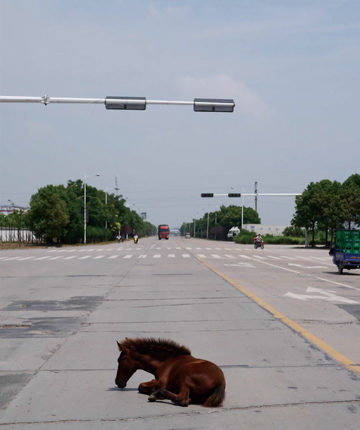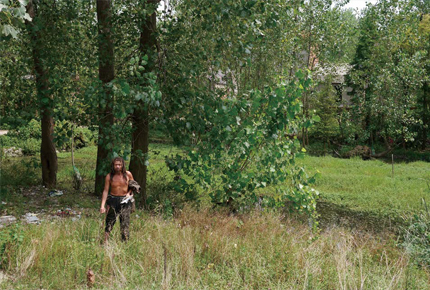WHAT IS THE URBAN-RURAL FRINGE, AND WHY IS IT THE URBAN-RURAL FRINGE?
| November 22, 2012 | Post In LEAP 17

The process of urbanization and the expansion of cities have created economic and physical spaces where urban and rural characteristics mingle together. Various land uses and administrative systems come together at what is known as the urban-rural fringe.
In fact, we (the Urban Rural Fringe Group) are not concerned with the aesthetic, political, and everyday reality of these economic and physical places. There is a broader abstract space implied by the concept of the urban-rural fringe: a place where various forces tangle and compete. We are interested in this space and the imaginable possibilities suggested by these tangling, competing forces.
The city is a concept of the rational world. This world has been rearranged according to calculations, plans, and knowledge. This world’s various activities all possess schematic intention: an anticipated result, a goal with a forecasted outcome. These calculations and schemes are always bound to some temporal future. They produce satisfactory utilitarian results. The signature trait of this world dominated by rationality is utilitarian production. It is ruled by the calculations, plans, and knowledge of reason; it is disciplined by order and prohibition. In this world— “a productive society, namely, useful society” (Georges Bataille)— all persons, things, knowledge, and practice correlate. They function mutually within a compact production chain. This world, the product of calculated and planned reorganization, rejects aimless practices, denying that which is wild and vital, manifesting what Nietzsche would describe as signs of decline.
The concept of the city also implies accumulation and excess. The city is rife with excess production, excess consumption, accumulated products, and accumulated landscapes. These excesses and accumulations expose how commodity fetishism rules this world.

We certainly cannot say that the rural world is a concept diametrically opposed to the urban world. The rural world is not the inverse of the urban world or the opposite of the rational world. But in many ways, the rural world is one realm that the powerful machine of the urban, rational world cannot touch. The city signifies a complete separation from nature. Of course, green spaces are an aesthetic component of cities. Through the “cosmetic surgery applied to green spaces” (Baudrillard), they serve as a theater in which the absolute, eternal struggle between man and nature is incessantly reenacted. People always want to prune naturally growing plants into geometric shapes that do not exist in the natural world. This is goal-oriented action. The laws of nature have no goals, of course, so if these plants are left unattended, they begin to grow in purposeless directions. Then people prune them again. People are always pruning and arranging these plants, which are always growing carelessly, escaping at sidelong angles. From this “cosmetic surgery” we see that mankind’s denial of nature is indeed indefatigable.
In the rural world, negation of and separation from nature is less thorough. Rural means of production entail deriving crops from the earth and raising livestock. Crops and livestock provide all mankind with the most basic energy required to survive, and the urban world must also continually obtain these crops and livestock from the countryside. The mechanisms of producing crops and livestock can be seen as mechanisms of collaboration between nature and people. The rural environment is a minimally modified version of nature. Compared to the urban world, the rural world has closer ties to nature and is more tolerant of aimlessness. Compared to the unbridled rationality of the city, the village manifests limited unruliness and primeval vitality. The purposefulness, order, excess, and accumulation of the city stand in contrast to the dispersion, disorder, scarcity, and impoverishment of the village.
The urban-rural fringe is the intermediate zone between the city and the countryside. It is a blurry boundary between two worlds that serves as a point of transit and transformation. The urban-rural fringe is always closely bound to roads. Main roads traverse the urban-rural fringe before passing through the countryside to other cities. Smaller roads connect the urban-rural fringe to the countryside, where they disappear into the expanses of nature. Roads are the manifestation of two concepts: first, leaving and returning to the countryside, and second, the flow of people and objects. Products move along roads, gravitating toward the locus of the market, from one city to another. Excess materials and valueless products— garbage— they stop here, piled up and sorted at the urban-rural fringe.

The behaviors of production produce large amounts of waste, as well as harmful dust and gases. The behaviors of consumption require clean, well-lit spaces (these behaviors also produce large amounts of waste), gradually taking over urban space. As a consequence, the sites of production— namely, factories— are gradually relocating to the urban-rural fringe. The spaces of the urban-rural fringe are gradually assuming the functions of production. Peasants who have lost their land become workers in factories as farmland becomes factory buildings. Oxen become assembly line machines and crops become products made from plastics, metals, ceramics, and other materials. These products supply the cities in an unceasing stream, and the surplus materials end up back here.
In addition to the surplus materials from products, there are also surplus materials from populations. The humiliated people, the peasants who have lost their land and yet have been rejected by the city, the trash collectors— they too accumulate at the urban-rural fringe, where surplus materials and people take on a new vitality. There is another social group, the stray dogs, that drift about at the urban-rural fringe. The dogs at the fringe include watchdogs from the countryside as well as abandoned pets from the city. These dogs were once a kind of product. They were raised, and they became people’s companions, a kind of second-class citizen integrated into human society. Dogs rely on people just as people rely on the objectified world, the material system. Stray dogs are abandoned objects. They either form bands or live independently. They associated with the garbage, deriving energy from it. Having gained independence from human society, they depend upon people’s surplus materials— a life of garbage. They inadvertently escape the system to form their own system, a new, alternative society. In fact, this society of stray dogs presents a portent of our future.
The urban-rural fringe is the boundary between the city and the countryside; it is also the boundary between reason and nature. The order, law, and discipline of the rational world meets the nature, disorder, and aimlessness of the natural world at the urban-rural fringe, where they ebb, flow, and entangle. In this contest, the urban-rural fringe, as a site of dissolution and recombination, continually produces new realities. Compared to the order of the city and the nature of the countryside, the urban-rural fringe presents a definitively noisy, chaotic, and filthy disorder. This noise, chaos, filth, and disorder mediate between the city and the countryside. This noise, chaos, filth, and disorder are also reactions of the laws of nature to the efficiency and rationality that dominate the urban world.
Given this premise, we can imagine the urban-rural fringe afloat between the two sides. It is a battlefield between rational and wild, order and nature. Only in the interaction and conflict between these elements can spontaneity and future possibilities emerge. The urban-rural fringe is a place rife with imagination, a place in which various possibilities and contingencies are manifest.

